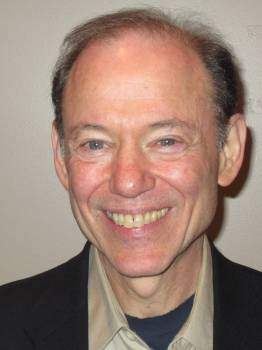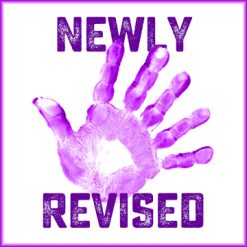|
Part 2:
Audiobook Dialogue: How To
Talk Real In Fiction & Non-Fiction  By Paul Ruben By Paul RubenAudiobook Producer & Director Tribeca Audio Inc. See Part 1
Assume that the following dialogue appeared in two books, identically titled: The Narrator's Nightmare. The only difference between the books: one is fiction, the other non-fiction. Imagine narrating first as if from the novel, and then non-fiction. "Oh my God," said Jane, "I just landed my first audiobook, Not My Fortune, Cookie, about a semi-retired, Chinese detective living in Boston who's been there so long she has an accent, except when she's speaking on the cell phone to her brother, Ling, in flawless Mandarin.
"Anyway, she comes out of retirement when her best friend, Elka - you guessed it, from Sweden - calls from her new home in Yankton, South Dakota.
"There's like, five major male suspects, and, I dunno, maybe four female. And, like, theyíre all the same age, and work at the same hog farm.
"I mean, how am I supposed to distinguish these people?
"And then, this one suspect bolts, drives cross country, and - I can't do this - there are these other characters: from west Texas, the south side of Chicago, north Baltimore, East Jesus, Arkansas, a Pakistani midget, a Russian tour group speaking real Russian, an Israeli rabbi barking dovining instructions to Long Island Jews, and a French geriatric nurse who mimics the home's residents back in Boston. "And, at the end, when the detective discovers the real crook - an unemployed Albanian clown - the other characters have a big reunion back in Yankton!
"And they all talk to each other fast and slurry, because Ling - who's in for the reunion - spiked the fruit punch! Oh, and it's virtually all dialogue."
MANY CHALLENGES Embedded in Jane's monologue (I'm sure many narrators can relate), are multiple dialogue-related questions and challenges.
First among them: Should Jane's "fiction" dialogue be performed differently when it appears in the "non-fiction" narrative?
My short answer to this question is: yes! Fiction dialogue should be approached differently than non-fiction.
Why? Because there is a fundamental difference between the performance-demand fiction and non-fiction place on the narrator.
Therefore, the performance-approach to each form must differ, fundamentally. After briefly explaining this notion, I'll suggest some of the specific dialogue challenges I've encountered with narrators and my how-to remedies for them. POINT OF VIEW For the narrator, what singularly distinguishes narrative fiction from non-fiction is point of view.
Characters who speak in narrative fiction speak literally for themselves. They are, the moment they speak, the three-dimensional star of their own show. They have an inner life; they are sentient.
Non-fiction characters are spoken for by the author. That is, non-fiction characters aren't really real. They have no inner life, no soul. They exist to further the author's intellectual purpose.
NON-FICTION DIALOGUE
Non-fiction characters speak on behalf of the author.
When a non-fiction author, writing about the Civil War, quotes General Lee, he is saying to his audience, albeit enthusiastically, "Hey, check out what Lee said. Understand this quote's salience."
His intent, by way of his own enthusiasm for this story, is to emotionally connect the listener to his intellectual purpose, not to the actor's rendition of Lee.
NON-FICTION DIALOGUE
For me, authentically recreating non-fiction dialogue means the narrator speaks "as if" she were the author, because from the listener's perspective, she is.
Remembering that the text reveals all, the non-fiction narrator's primary performance obligation is to determine the author's feeling about her subject, her overall emotional state.
That is, does the book's syntax reflect happy, sad, glib, prosaic, intellectual, wistful, sublime, etc.?
FINDING FEELINGS
Having determined how the author feels, the narrator affects a persona, intimately, that embodies the author's feeling, then grasps the listener's imagination as if she were the author.
When talent have difficulty replicating the author's feeling, I often suggest they imagine this author, again, depending on the syntax, as a teacher, a company CEO, or some other authority figure.
"Authority" is a common denominator for all non-fiction authors. Voice over actors can then pretend they are speaking enthusiastically to a small class or group. ADOPT A PERSONA
Adopting the appropriate performance persona is the key to unlocking non-fiction's fundamental performance challenge: recreating the author's emotional state.
Once that's known, all dialogue is spoken as if by the author, as opposed to the particular character or figure.
So, when the narrator, imaging the author as, say, an enthusiastic university professor quoting General Lee to her graduate students as if she's about to impart the meaning of the war, it is not Lee speaking but rather the author speaking for him.
Is it ever acceptable to imbue non-fiction's characters with an identifiable voice? No. Never.
Does that mean the dialogue should be flat, read unemotionally? Of course not.
HONOR THE TEXT
When the author's enthusiasm for this amazing story - as opposed to showing off her Southern accent - is exercised, the characters honor the text, vibrantly.
Finally, for talent who just can't control the impulse to tweak Chairman Mao as he quotes the Little Red Book, it's instructive to remember that your impulse opposes the author's purpose: to assert an intellectually compelling proposition.
Your Chinese accent, authentic as it may be, merely redirects the listener to your performance. At that point the storyteller has upstaged, rather than enhanced, the narrative.
The stage belongs to the intellectual purpose, not characterization. And it's worth remembering that the consumer hasn't purchased Mao's China to assess the narrator's accent.
FICTION DIALOGUE
How to play the opposite sex? How to distinguish same-sex characters when they are assigned no distinguishing features?
How to yell when you canít yell? Cry when you canít cry? (Or can you?)
How to create a Japanese accent without it sounding like Saturday Night Live? Or a German accent when you havenít a clue? And that dreaded Boston accent? Do they all sound like JFK?
For me, dialogue challenges, along with all performance-related issues, are best addressed by combining useful performance rubrics with acquisition of concrete, result-oriented vocal techniques that quickly assist in creating organic dialogue choices.
ENGAGE THE AUDIENCE
First: Stay connected. The listener's willing suspension of disbelief is the narrator's priority.
A vocal choice, for a particular line or even word, that emotionally disconnects listeners from the narrative means the storyteller has failed to engage his audience.
Second: All dialogue, naturalistic, sci-fi, fantasy, whether or not the syntax appears comprehensible, is real.
Dialogue is grounded in the character's reality. Language emerges from inside the character.
Speech, including non-verbal sounds, expresses a character's given feeling at a given moment in time. Therefore, all dialogue is real.
Third: Act the subtext. To be sure some dialogue appears so over-the-top, melodramatic or nonsensical, one can only gasp, who wrote this?
But the performance-truth must be that all characters are carbon based. All humans have an inner life. No matter how silly that life may appear to the narrator, it's important to the character.
That inner life is where the "eggs" are, where the subtext resides. The more vocal tools a narrator possesses to discover the subtext, the closer she comes to speaking authentically.
Fourth: There is no bad dialogue, only speaking it badly.
A final admonishment before discussing dialogue technique: So-called technique, that is, vocal choices imposed by the narrator to affect a given line, only achieves its purpose when the listener is aesthetically tricked into believing that the line's emotional revelation has occurred "organically."
That is exactly why modulation, or any vocal technique, that's imposed merely to create vocal variety sounds phony or not quite right to the listener, bores him or simply has no emotional resonance.
Humans are connected to emotion, not variety.
LESS VOLUME = MORE CONNECTION
The general drama axiom is that less volume equals more emotional connection. Less is more, almost always.
Axiomatically, the more emotion, the less volume is needed to voice it.
Why? I don't know the psychology, but I would argue that when I stage whisper, "I will kill you,Ē I intimately connect the listener to my psyche, invite her in, to feel what I feel.
Too much voice and I risk "indicating" my feeling and disconnecting emotionally from the listener.
When in doubt, less voice is more, particularly in drama.
HOW TO GET LAUGHS
The general comedy axiom is that bigger is better. The more volume, the more presentation, the more "indicating."
"Why?Ē said Sadie.
"Oy! Why not, bubela!Ē said Moishe.
Comedy is an intellectual experience, not an emotional one. We laugh at what we know (or reference), not what we feel.
Understanding a reference can make us laugh. Empathy can make us cry. Never the reverse.
SPEAKING-REAL TOOLS
How does one believably say, "Next time Sarah, you won't have your soldier boy to save you, so remember, I'm watching, Sarah. I'm watching."
It ain't easy because this dialogue screams phony-melodrama-no-one-talks-this-way-except-authors-who-can't-write-dialogue.
The narrator's response to this - and all dialogue, really - must be to ferret out the subtext, to discover the character's inner life, to assert the right tone.
The ferreting tools are pace, pause, and volume. Each tool is activated by what I've put in quotes and believe is an "actable" direction.
Pace. "Don't let the words come out quickly. Hold back, hold back."
This simple, physical response, literally disallowing the words to simply stream out of the mouth, permits the actor time to intuit feeling, to connect to the character, rather than merely rattle off words or affect a pace disconnected from an inner reality.
Pause. "Remember, you have no idea what you're going to say next."
Metaphorically, the subtext lives between the words, among or beneath them. When the actor literally pauses, as if to "work at discovering" what she wants to say next, she intuitively stops - if for only a fraction of a second - to connect to the character's inner world, to what propels the character to speak those words.
Volume. For drama, use "less voice, more stage whisper. Less. No, even less."
As I mentioned earlier, less voice, particularly stage whisper, creates intimacy, is an emotional connector and heightens the stakes.
For comedy, use "more voice, more." Trust that the danger is under-acting.
PLAYING OPPOSITES
Voicing the opposite sex?
If you're a woman, play the man, not the baritone. If you're a man, remember, women have feelings all their own.
Yes, a woman can literally lower her voice a bit, a man can affect a slightly breathier quality, but at the risk of stereotyping, the actor's preferred choice could be to play the traits that distinguish the opposite sex.
My choice - especially when there are multiple opposite-sex characters that seem to sound alike - is to focus the talent on finding a distinguishing male or female cadence, tone, or overall attitude, as well as changing the voice.
AFFECTING ACCENTS
Play the intent, not the accent.
And if you even think you can't imitate a believable German accent, you're right. Donít go there. For the accent-challenged there's more than one way to sound foreign.
For example, slightly formalizing your English might be enough to suffice as an Asian accent. Finding a particular vowel sound that replicates a geographical region may be enough to keep the listener in willing suspension of disbelief.
It's worth considering that nothing disrupts a compelling story when a listener thinks, "She's supposed to be from Ireland, not New Jersey."
REVEAL FEELINGS Dialogue's revelation is feeling, not information. What the words signify, what they mean, is the authorís responsibility.
Besides, it's impossible to "act" meaning.
What's actable is the character's feeling about whatever he's speaking of, or shouting, crying or laughing about. Feeling is where the dialogue's emotional form emerges from.
I sometimes encounter actors who fret about getting the line's point across: Am I communicating the character's thoughts?
Fair concerns, yes. But really, any given line's salient concern must be: Am I communicating the character's feelings?
ABOUT PAUL ...
Paul Ruben has produced and directed numerous award-winning audiobooks for every major publisher since 1987. His many Audie Awards include work for It's Not About the Bike, Raymond and Hannah, The World is Flat, A Slight Trick of the Mind. He also received the 2003 Grammy (Best Spoken Word Album) for Al Franken's Lies and the Lying Liars Who Tell Them, and the 2009 Grammy for Always Looking Up by Michael J. Fox. He has directed regional and summer theatre productions, contributed features on audiobook narration to AudioFile magazine, and was elected to the Audio Publishers Association Board of Directors in 2005. Based in New York City and casting and directing many first-time narrators - some of whom have become outstanding and award-winning working narrators - he also teaches audiobook narrator workshops through his company, Tribeca Audio.
Email: paul@tribecaaudio.com Web: www.tribecaaudio.com Narrator's Workshops: www.tribecaaudio.com/narrators_workshop.html |
As of the NEW website launch, 03/22/2012










I don't think I've ever encountered this topic covered so clearly, and with so much common sense. I'm interpreting what you are saying here as really a process in prioritizing - it's the emotional and intellectual INTENT of the author's story - fiction or nonfiction - that counts here...and making the choices to honor that (German NOT Jersey) is the most important value in guiding a narrator's choices. At least I think I have that right. Thanks so much for sharing so much of your wisdom and experience here!
As Dirty Harry put it, "A man's got to know his Limitations"
Cheers,
dc
BTW, years ago I almost bought a house in Yankton, SD.